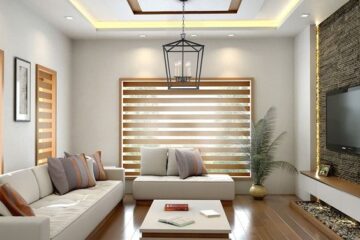Magical isn’t too fabulous a word to describe architect Christian Zapatka’s transformation of an 8,000-square-foot, 1970s colonial-style house in Potomac. The clients, a successful entrepreneur and his wife, wanted to enlarge the family home they loved, infusing it with more natural light and style—but not the ostentation of a mammoth remodel.
Zapatka preserved the original house’s core within a sleek, stucco-clad expansion that more than doubled its size. “As the plans grew,” he says, “I kept a template firmly in mind: Let there be no huge spaces or scale to confront. We want to meander pleasantly through a cherished family home.” His genius was in avoiding the pitfalls of what has become an architectural anathema: the McMansion. Big houses need not be formidable or formulaic, as illustrated by Zapatka’s sensitive handling of this one.
The wife had previously worked with Washington, DC, designer Frank Babb Randolph, refining rooms in the original house. He sourced art and updated their furniture, finding unique pieces that wouldn’t go out of style. When the husband suggested that a master suite in a new first-floor addition might work wonders for his ailing knee, Randolph proposed Christian Zapatka for the design—beginning a five-year process during which the modest master-bedroom addition grew into a three-story wing housing a family room, playroom, gym, spa, movie theater, large master and guest suites—and even a subterranean half-basketball court.
When Zapatka first walked through the front door, he quickly began suggesting options that ranged from tearing the house down to building anew on another lot. When the couple, who have four children, concluded that they loved their wooded, two-and-a-half-acre property too much to leave it, an intense discussion ensued about ways to expand the existing home. The wife declared, “Don’t change the layout of the old house! We’re comfortable and it has a great flow.”
Heeding her words, Zapatka says he “massaged the existing kernel of the house” in his design of an addition that extends along its north side, perpendicular to the original structure. He preserved the smaller scale of the original house from the front by siting the bulk of the expansion so it extends down an adjacent slope. An entry courtyard nestles in front, with Belgian pavers that lend it a European feel.
Resurrecting a sketch he’d made of a marble fountain in Rome while completing a fellowship as a recipient of the coveted Rome Prize for Architecture, Zapatka commissioned a fountain to be sited along the home’s front door axis. “It plays up the sense of a palazzo,” he explains. A line of four garage bays borders the courtyard (the original garage is now a library).
In the existing structure, the living and dining rooms retained their original positions near the front entry, as did the kitchen and breakfast room to the rear. A 24-foot gallery created an axis behind the new library, and facilitated the addition of a wine room. Replacing the home’s simple wooden deck, a spacious loggia now overlooks a sumptuous swimming pool and spa, outdoor kitchen, sport court and gardens, created by Washington-based landscape designer Jane MacLeish.
Zapatka overlaid the home’s brick exterior with smart neo-classical styling. Stucco sheathing, light-emitting bay windows and European casements conform beautifully to the original symmetry while plain surfaces and flat limestone casings deliver a look more reminiscent of 1920s Vienna than 1970s suburbia. “The composition is still classical but it’s spare,” he says. It also facilitates a whole new architectural vocabulary inside, he adds, which “lets the proportions of the old house and new addition speak to each other.”
Working closely with Randolph, Zapatka devised clever modifications to join old and new elements. Heightened door frames, bleached white-oak flooring throughout and less imposing mantels “fool the eye into perceiving larger volumes in the old, low rooms,” Zapatka says. Randolph’s characteristic restraint regarding color and his choice of spare, sculptural furnishings further the “less is more” approach.
But it’s the architectural detailing that creates cohesive style. Bolection molding around doors and windows provides a basic language of flow between rooms. Bold and minimal, “it’s a starved classicism,” Zapatka says, “the very basis of elegance.”
His classicism is the platform for some flourishes, too: The gallery’s march of pilasters ends in a rusticated Roman arch sheltering a fountain, while steel columns designed for the loggia recall a bundled-reed motif from ancient Rome. Zapatka channeled Art Deco in his reiteration of triple glass panels in doors and windows as well as in the design of the foyer’s curved staircase and distinctive steel rails.
Another classical touch is an oval recess within a tray ceiling in the master bedroom. Randolph, who masterminded the room’s color scheme, describes its icy blue as “receding into the ceiling’s Baroque blue sky…you almost want cherubs up there.”
In striving for simplicity, Zapatka’s elegant design created a great deal more.
Writer Susan Stiles Dowell is based in Monkton, Maryland. Gordon Beall is a photographer in Bethesda.
ARCHITECTURE: CHRISTIAN ZAPATKA, AIA, FAAR, Christian Zapatka Architect, LLC, Washington, DC. INTERIOR DESIGN: FRANK BABB RANDOLPH, Frank Babb Randolph, Washington, DC. RENOVATION CONTRACTOR: OC Builders, McLean, Virginia. LANDSCAPE DESIGN: JANE MACLEISH, Jane MacLeish, Washington, DC.
RESOURCES
Architecture: Christian Zapatka Architect, LLC; christianzapatka.com. Interior Design: Frank Babb Randolph Interior Design; 202-944-2120. Landscape Design: Jane MacLeish Landscapes; janemacleish.com. Builder: OC Builders; 703- 454-8499.
THROUGHOUT Windows & Exterior Doors: tradewoodindustries.com. Flooring: majesticwoodfloors.net. Home Automation: imsva.com. Interior Doors: trustile.com.
COURTYARD Steelwork: Eric Hermansen, Lars, Inc.; handcraftedstair.com. Fountain Fabrication: rugostone.com. Stone Paving: stoneworksinc.us.
ENTRY HALL Stair-Rail Fabrication: handcraftedstair.com. Console: centuryfurniture.com. Console Paint Treatment: lenorewinters.com. Vintage Mirror: 1stdibs.com/dealers/david-bell.
DINING ROOM Silver-Leaf Ceiling: lenorewinters.com. Table: keithfritz.com. Chairs: Frank Babb Randolph for davidiatesta.com.
LIVING ROOM Mantel: chesneys.com. Club Chairs: jlambeth.com. Silver-Leaf Coffee Tables: century
furniture.com. Artwork: Owners’ collection.
GALLERY Carved 19th-century Face & Basin: 1stdibs.com/dealers/david-bell. Decorative Paint: lenorewinters.com. Sconces: niermannweeks.com.
LIBRARY French Jacobean-style Wing Chairs: dessinfournir.com. Armchairs: davidiatesta.com. Millwork: Winchester Woodworking; 540-667-1700.
WINE ROOM Stone Wall & Flooring: rugostone.com. Millwork: oldtownwoodworking.com.
SUNROOM Vintage Bamboo Brighton Pavilion Chairs: 1stdibs.com/dealers/david-bell. Bridge Table: Frank Babb Randolph for davidiatesta.com.
LOGGIA Rail Fabrication: handcraftedstair.com. Furniture: janusetcie.com. Lanterns: niermannweeks.com.
MASTER BEDROOM 1920s Mantel: chesneys.com. Mirrors: Frank Babb Randolph for davidiatesta.com. Chandelier: niermannweeks.com. Ceiling-Paint Treatment: lenorewinters.com.
Painting & Club Chairs: Owners’ collection.
Spa Furniture: janusetcie.com. Tile: waterworks.com.
MASTER BATH Tile & Fixtures: waterworks.com. Millwork: Winchester Woodworking; 540-667-1700.
[Source:Home & Design]


